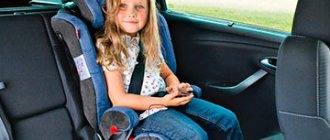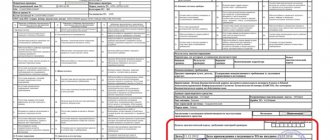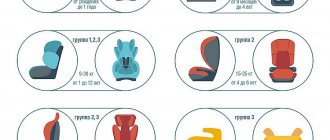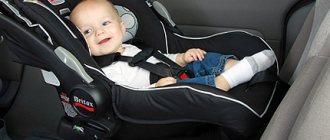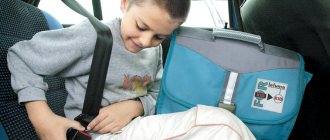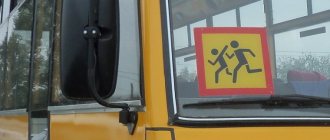Can I transport my child in a booster seat - quick test
1. What is the age range of your child?
Less than 7 years 7-11 years 12 or more years
2. Does the booster have one of the following markings on the body or a corresponding certificate in the form of a document: “UNECE No. 44-04”, “GOST R 41.44-2005” or “ECE R44/04”
Not really
2. Does the booster have one of the following markings on the body or a corresponding certificate in the form of a document: “UNECE No. 44-04”, “GOST R 41.44-2005” or “ECE R44/04”
Not really
You can transport your child simply by fastening him with a standard seat belt. But if the top strap of the seat belt goes over the child's neck, it is recommended to place him in a booster seat or child car seat. Go through again
You can transport your child simply by fastening him with a standard seat belt, only in the back seat of the car. But if the top strap of the seat belt goes over the child's neck, it is recommended to place him in a booster seat or child car seat. Can be transported in the front seat in your certified booster seat. Go through again
You can only transport your child in a booster seat or child car seat that meets the above requirements. Go through again
You need another booster certified according to the specified Rules. Your current booster is unsafe and you may get a fine if you use it. Go through again
You can transport your child simply by fastening him with a standard seat belt, only in the back seat of the car. But if the top strap of the seat belt goes over the child's neck, it is recommended to place him in a booster seat or child car seat. You cannot carry a child in the front seat, as this can only be done in a certified booster or car seat, but your current booster is not certified, is unsafe and you can get a fine if you use it. Go through again
What do the 2021 traffic rules say?
The last time the Rules were adjusted regarding the issue of transporting children and boosters, in particular, was in July 2021. And then clause 22.9, which regulates the rules of transportation, became even more confusing. There is no specific mention of any device:
- no child seat
- no booster in the context of the child’s age,
- nor any kind of adapters or other devices.
There are only two common vague terms:
- child restraint,
- child restraint system.
At the same time, it is not said whether these are the same thing or different devices for transporting children.
22.9. Transportation of children under the age of 7 years in a car and truck cab, which are designed with seat belts or seat belts and an Isofix child restraint system, must be carried out using child restraint systems (devices) that are appropriate for the weight and height of the child.
The name of the ISOFIX child restraint system is given in accordance with the Technical Regulations of the Customs Union TR RS 018/2011 “On the safety of wheeled vehicles”.
Transportation of children aged 7 to 11 years (inclusive) in a passenger car and truck cab, which are designed with seat belts or seat belts and an ISOFIX child restraint system, must be carried out using child restraint systems (devices) that are appropriate for the weight and height of the child , or using seat belts, and in the front seat of a car - only with the use of child restraint systems (devices) corresponding to the weight and height of the child. The installation of child restraint systems (devices) in a passenger car and the cabin of a truck and the placement of children in them must be carried out in accordance with the operating instructions for the specified systems (devices).
It is prohibited to transport children under the age of 12 on the back seat of a motorcycle.
So, we see that there is a gradation according to the child’s age and rules for transportation in the back and front seat of a car:
- up to 7 years - both in front and behind only using child restraints,
- from 7 to 11 years old - only with child restraints in front, can be fastened with a seat belt in the back,
- From 12 years old you can wear a seat belt.
You will also be interested in:
- Can frameless child car seats be used in a car? From what age?
- Fines for violations of the rules for transporting passengers in situations
- A child in the front seat - at what age can you drive under the new law?
At what weight of a child can a booster be used?
Similar to height, regardless of height - again, the traffic rules are based on age, not weight. But, unlike height, in relation to weight, each booster and child car seat has weight restrictions - according to this parameter, boosters are even divided into their own classes-groups:
- 2/3 – for children weighing from 15 to 36 kg,
- 3 – for body weight from 22 to 36 kg.
And it is precisely in this regard that the correspondence of the holding device to the weight and height of the child is expressed in a suitable booster depending on these parameters. And, unlike growth, here a fine is more likely. Although, it is unlikely that the inspector will weigh your child, and it is unlikely that he will have the technical ability to do this.
Can a booster be used at what age of a child?
Let's return to our main question about the possibility of placing a child in a booster seat - at what age can this be done according to traffic rules in 2021? To answer, we need to understand what a booster is by law. And the Rules refer us to the Technical Regulations.
Looking at the latter, we understand that the child restraint system must comply with UNECE Regulations No. 44-04 (Appendix No. 10 - “List of requirements for types of vehicle components”). If your booster meets these requirements, then you can transport your child in the booster.
Finding out about such compliance is quite simple: there should be a corresponding marking on the label on the booster itself. In this case, 2 options for representing the notation are possible:
- Russian-made boosters are, as a rule, marked “UNECE No. 44-04” or “GOST R 41.44-2005” (the latter GOST is the Russian version of the UNECE Rules),
- Imported boosters are most often marked as “ECE R44/04” - this also means that the device meets the requirements of the Economic Commission for Europe.
Boosters with this marking can transport children of any age. In very rare cases, boosters may not have any markings on the case at all, but only in the documents. In this case (and in general always), when purchasing, you should request a certificate of compliance with the above rules. Otherwise, you may be legally fined.
Expert opinion
Yuri Panchenko
Driving instructor, human rights activist, author of books. 10 years of experience.
As correctly stated in the article, the requirements for child restraints are regulated by UN Regulation No. 44-04.
GOST R 41.44-2005 has lost force since 01/01/2018, but if the child seat indicates the date of manufacture before the specified date, and there is a plate of compliance with GOST R 41.44-2005, then there should be no claims from the traffic police.
The use of boosters is governed only by UN Regulation No. 44-04. They must also have a conformity label. Moreover, the booster must be manufactured after 02/09/2017, when the relevant amendments entered into force. This device is used for children with a height of 125 to 150 cm and a weight of 22 to 36 kg.
If a child is taller than 150 cm or weighs more than 36 kg, then there are no child restraints for him. Then we fasten the child with a regular standard seat belt in the back seat.
Ask a Question
What is a booster for children
A booster seat for children is a type of car child restraint system (CAC).
The main purpose is to artificially increase the height of a child in a sitting position to secure him with a standard seat belt, the standard design of which is designed for a person with a height of 150 cm.
The main function of a booster seat for children is to increase the safety of transporting children without the use of a full-fledged restraint device, which is achieved by complying with the following conditions:
- fixing the child’s position in the event of a possible collision using a stationary attachment of the pillow at three points;
- correct direction of the car seat belt - over the shoulder and hips;
- quick disembarkation of the child from the cabin.
It is an ergonomic seat with armrests, does not have a backrest or side protection, and uses the back of a car seat as a support. Subject to mandatory certification in accordance with GOST R 41.44 - 2005. or with the UNECE European Safety Standard No. 44-04.
It is allowed to place the booster in the direction of travel on the front or rear seats in accordance with the requirements of the operating manual for each individual device.
At what age can you travel without a booster?
The answer to this question is already clearly given to us by the 2021 traffic regulations:
- if the child is under 7 years old, then he can only be transported in a child booster seat or seat (in compliance with the latest UNECE rules No. 44-04),
- from 7 to 11 years old, children can be transported without boosters at all in the rear seats, and only in a booster or child seat in the front seat,
- From the age of 12, a child can ride, fastened only with a standard seat belt, in any seat.
You can, but you don't need to!
It should be borne in mind, however, as we have already mentioned above, that no fine can logically take precedence over the safety of children. And it’s not for nothing that the traffic rules mention the compliance of a child restraint system with the child’s height and weight.
The fact is that for many children over 7 years old, when they can be transported without a booster according to the Rules, the standard belt (top strap) runs exactly along the neck. This should not be allowed, since in an accident the risk of fatal injury is even higher than if the child were driving unbelted. To confirm this, you can watch the very first crash test video of the dummy below.
Therefore, the issue must be approached strictly individually - most often it is still recommended to use a booster seat or a child seat, regardless of how old the child is and whether this is in compliance with the traffic rules.
Also, if the Rules allow you to transport a child without a booster, but you use it for safety reasons, then the booster’s compliance with the rules is no longer critical for compliance with the law (but they still mean that the booster has passed the necessary tests and is safe for your child).
Something else useful for you:
- We drove under the camera at a yellow traffic light: will there be a fine and how to appeal?
- Is there a fine for driving on summer tires in winter and winter tires in summer today? What date will it start?
- Traffic regulations about passing a stationary car on a continuous road: what is the fine and is it possible to cross?
What is the penalty for incorrect transportation in a booster?
The fine for violations of the rules for transporting children for 2021 is general - it is 3,000 rubles under Part 3 of Article 12.23 of the Administrative Code. It will be issued to you if:
- You are transporting a child under 7 years of age in a vehicle without a booster seat or any other approved child restraint device,
- You are transporting a child from 7 to 11 years old in the front seat without these same devices,
- You are transporting an unbelted child over 12 years old,
- the child is sitting in the booster seat, but is not fastened or the booster itself is not fastened (in cases where this is provided for by the design of the booster itself).
This fine can be paid with a 50% discount during the first 20 days after the decision is issued (and later in some cases). The cameras do not record this traffic violation, and evacuation to the impound lot is not provided.
The peculiarity of this fine lies in two important subtleties:
- it can be prescribed every time the car starts moving (even by the same inspector), no days for elimination,
- If you are transporting 2 or more children without a booster or with other violations of the transportation rules, then only one fine should be assigned per stop, since the very fact of violating the transportation rules is punished specifically.
Expert opinion
Dmitry Tikovenko
Automotive law expert. 7 years of experience. Areas of specialization: civil law, disputes over compulsory motor liability insurance and road accidents
This article will be of interest not only to young mothers and fathers, but also to those who transport children for official reasons. We are talking about taxi drivers.
If you violate the rules for transporting children when providing transportation services in a taxi, then the driver will not get away with simply fines from the Administrative Code. This act can already be qualified as the provision of services that do not meet safety requirements, which means that the driver will be held accountable under another article and even under another code - criminal. In the code, this is Article 238, and the punishment here can be either a fine or imprisonment.
Ask a Question
What's the fine?
It amounts to 3,000 rubles under Part 3 of Article 12.23 of the Administrative Code.
The fine is the same for any violation of the rules for transporting children and can be issued:
- if you are transporting a child under 7 years old without using a car seat or booster,
- if you are traveling with a child under 12 years old in the front seat without a restraint device,
- if the booster or child seat does not correspond to the weight of the child (a fine may be issued in rare cases),
- if the restraint system does not correspond to the child’s height (in practice there were no cases).
There are no other additional punishments or security measures for this: no impound, no deprivation of rights, no other sanctions. But it should be remembered that every start of movement, including after being stopped by the traffic police officer who issued the fine, forms a new offense, and by law the inspector can stop you at least every 2 meters.
About FEST adapters
While discussing the booster, we should also mention various types of adapters for children, the most common of which is FEST. And it has recently been banned for use on the territory of the Russian Federation. The ban was established by Rosstandart as not complying with the same EEC rules, although FEST formally assures that their adapters still meet these requirements.
Meanwhile, various tests of FESTs have long shown their danger in road accidents - mainly the traumatic effect on the child’s abdominal cavity.
